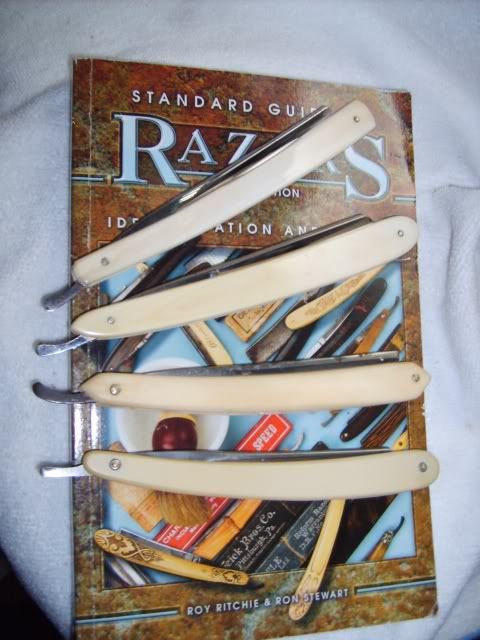Results 1 to 10 of 40
Thread: A sure test for ivory scales
Hybrid View
-
04-17-2011, 02:41 AM #1

You can also use the old school pin test to check for ivory. Take a needle or straight pin and heat up the tip with a lighter. Then find an inconspicuous part of the scales and touch the hot pin to it. If it's plastic/celluloid it will start to melt. If it's ivory it will smell like burning hair. I would only use this test after all other avenues of identification come up empty.
-
04-17-2011, 02:47 AM #2
-
04-17-2011, 03:04 AM #3
-
04-17-2011, 03:54 AM #4

In addition to above, often ivory is assembled with silver pins, no washers/collars. Along with metal wedge. Not a hard a fast rule, but a solid general observation.
-
The Following User Says Thank You to dirtychrome For This Useful Post:
nessmuck (04-17-2011)
-
04-17-2011, 05:49 AM #5

IMHO, there's no need to go poking it with a hot needle to check for it's material. More often than not, you can get that same smell just from hand polishing the scales....you're likely to do it anyway. Just start polishing until you build up a mild heat on your rag and then give the scales a sniff. Celluloid will have a chemical/camphor smell to it and ivory will not.
-
The Following User Says Thank You to red96ta For This Useful Post:
nessmuck (04-17-2011)
-
04-17-2011, 08:37 AM #6

Lightly clack the scales against your teeth. Ivory and bone scales make a distinct noise as compared to celluloid. Bone is easy to identify with it's darks spots and grain. Compare the sound to that of scales you know are celluloid and that should tell you as well.
-
The Following User Says Thank You to Joe Edson For This Useful Post:
nessmuck (04-17-2011)
-
04-17-2011, 09:12 AM #7Senior Member

- Join Date
- Oct 2010
- Posts
- 123
Thanked: 18
Ivory is easy to determine. Real ivory has a distinctive appearance, grain and texture. It should be creamy-coloured or off-white, with a smooth grain to it. If it's perfectly smooth - it's celluloid. Don't be fooled. Real ivory feels a little gritty.
Bone often has little pits and holes in it. Ivory won't have that. Real cleaned, polished ivory will be smooth but not completely so. I believe that somewhere (either here or at B&B) there was a thread which showed photographs of razors with ivory, bone and celluloid scales. As I can't find it, I'll do the next best thing...

These scales are celluloid. Also called "French ivory".

While they're not straight-razors, all these things here are made of ivory. As you can see, it's off-white in colour, but not the light-yellow custardy look of the razor above, with the celluloid scales.
-
04-17-2011, 09:17 AM #8

Post a picture and we'll give you a good idea. I agree with all that has been said above, and I'll add that once you've seen ivory in hand, elephant ivory that is, you'll almost always be able to identify it instantly in future.
-
04-17-2011, 07:25 PM #9

Here are four in a row: Ivory, Antique Ivory, Bone and Celluloid:

Ivory has a very soft luster when polished with toothpaste or polishing compound; notice the light reflected across the top razor. Bone has fine inclusions of dark matter/stain. Celluloid often has a pattern almost like a fabric when held at different angles to the light.
As mentioned above the Ivory scales I have seen usually have no washer. they also may crack if you try to re-tighten them.
Respectfully
~RichardBe yourself; everyone else is already taken.
- Oscar Wilde
-
-
06-05-2011, 04:44 PM #10

Some ivorine celluloid can have a pretty convincing-looking fake grain, but it tends to be larger-scale and suspiciously regular. Ivory is also (one of the reasons for its desirability) slightly less slippery when wet.


 9Likes
9Likes LinkBack URL
LinkBack URL About LinkBacks
About LinkBacks







 Reply With Quote
Reply With Quote



